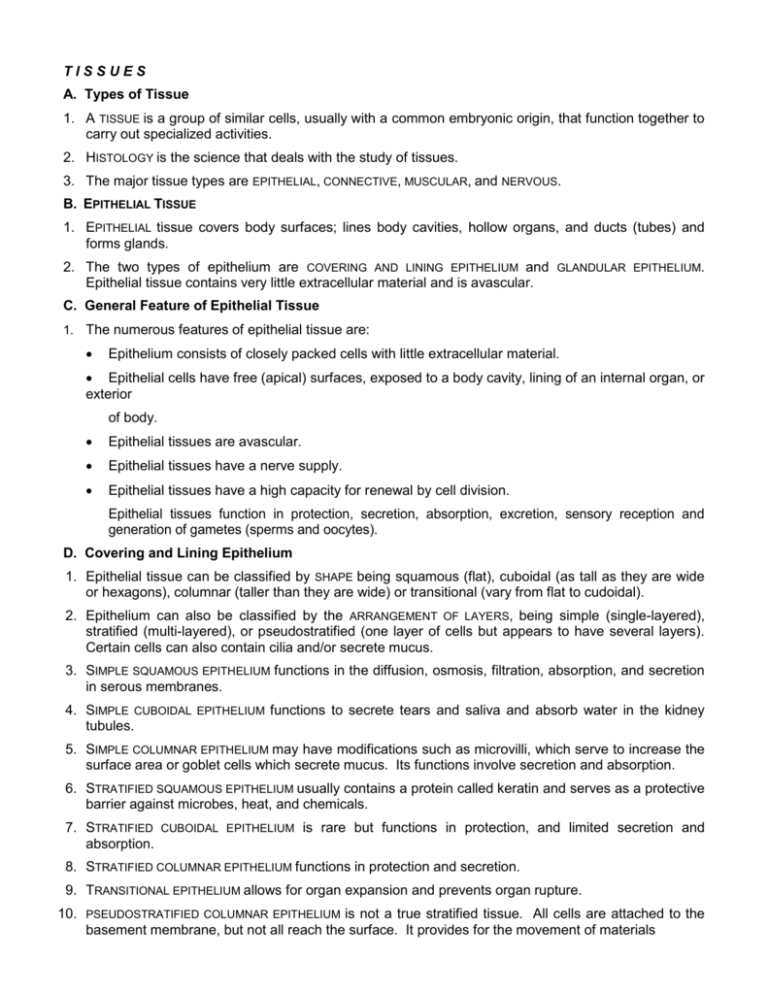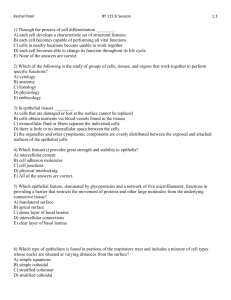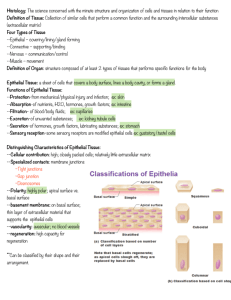Tissue - Fulton County Schools
advertisement

TISSUES A. Types of Tissue 1. A TISSUE is a group of similar cells, usually with a common embryonic origin, that function together to carry out specialized activities. 2. HISTOLOGY is the science that deals with the study of tissues. 3. The major tissue types are EPITHELIAL, CONNECTIVE, MUSCULAR, and NERVOUS. B. EPITHELIAL TISSUE 1. EPITHELIAL tissue covers body surfaces; lines body cavities, hollow organs, and ducts (tubes) and forms glands. 2. The two types of epithelium are COVERING AND LINING EPITHELIUM and GLANDULAR EPITHELIUM. Epithelial tissue contains very little extracellular material and is avascular. C. General Feature of Epithelial Tissue 1. The numerous features of epithelial tissue are: Epithelium consists of closely packed cells with little extracellular material. Epithelial cells have free (apical) surfaces, exposed to a body cavity, lining of an internal organ, or exterior of body. Epithelial tissues are avascular. Epithelial tissues have a nerve supply. Epithelial tissues have a high capacity for renewal by cell division. Epithelial tissues function in protection, secretion, absorption, excretion, sensory reception and generation of gametes (sperms and oocytes). D. Covering and Lining Epithelium 1. Epithelial tissue can be classified by SHAPE being squamous (flat), cuboidal (as tall as they are wide or hexagons), columnar (taller than they are wide) or transitional (vary from flat to cudoidal). 2. Epithelium can also be classified by the ARRANGEMENT OF LAYERS, being simple (single-layered), stratified (multi-layered), or pseudostratified (one layer of cells but appears to have several layers). Certain cells can also contain cilia and/or secrete mucus. 3. SIMPLE SQUAMOUS EPITHELIUM functions in the diffusion, osmosis, filtration, absorption, and secretion in serous membranes. 4. SIMPLE CUBOIDAL EPITHELIUM functions to secrete tears and saliva and absorb water in the kidney tubules. 5. SIMPLE COLUMNAR EPITHELIUM may have modifications such as microvilli, which serve to increase the surface area or goblet cells which secrete mucus. Its functions involve secretion and absorption. 6. STRATIFIED SQUAMOUS EPITHELIUM usually contains a protein called keratin and serves as a protective barrier against microbes, heat, and chemicals. 7. STRATIFIED CUBOIDAL EPITHELIUM is rare but functions in protection, and limited secretion and absorption. 8. STRATIFIED COLUMNAR EPITHELIUM functions in protection and secretion. 9. TRANSITIONAL EPITHELIUM allows for organ expansion and prevents organ rupture. 10. PSEUDOSTRATIFIED COLUMNAR EPITHELIUM is not a true stratified tissue. All cells are attached to the basement membrane, but not all reach the surface. It provides for the movement of materials 11. A SUMMARY OF EPITHELIAL TISSUES: TYPES OF TISSUE LOCATION FUNCTION simple squamous LINES HEART, LYMPHATIC VESSELS AND ABDOMINAL CAVITY, AND SEROUS SECRETIONS FILTRATION, ABSORPTION, DIFFUSION, OSMOSIS SIMPLE CUBOIDAL COVERS OVARIES, LINES KIDNEY TUBULES AND PART OF THE EYE LENS, AND FORMS PART OF THE RETINA SECRETION AND ABSORPTION SIMPLE COLUMNAR LINES GI TRACT FROM STOMACH, EXCRETORY DUCTS OF GLANDS, AND GALL BLADDER SECRETION AND ABSORPTION SIMPLE CILIATED COLUMNAR LINES UPPER RESPIRATORY TRACT, UTERINE TUBES, AND UTERUS MOVES MUCUS BY CILIARY ACTION STRATIFIED SQUAMOUS LINES THE MOUTH, TONGUE, ESOPHAGUS, VAGINA, AND OUTER LAYER OF THE SKIN PROTECTION STRATIFIED CUBOIDAL COMPRISES DUCTS OF SWEAT GLANDS AND MALE URETHRA PROTECTION AND LIMITED SECRETION AND ABSORPTION STRATIFIED COLUMNAR LINES MALE URETHRA, PART OF THE CONJUCTIVA OF THE EYE PROTECTION AND SECRETION TRANSITIONAL LINES URINARY BLADDER AND PARTS OF URETER AND URETHRA PREVENTS DISTENTION PSEUDOSTRATIFIED COLUMNAR LINES LARGE EXCRETORY DUCTS, EPIDIDYMIS, MALE URETHRA, AND EUSTACHIAN TUBES, UPPER SPERM RESPIRATORY TRACT AND MALE REPRODUCTIVE SYSTEM SECRETION AND MOVEMENT OF MUCUS E. GLANDULAR EPITHELIUM 1. The function of glandular epithelium is SECRETION. 2. A gland consists of one cell or a group of highly specialized epithelial cells secreting substances into ducts, onto a surface, or into the blood. 3. EXOCRINE GLANDS secrete products into ducts (tubes) that empty at the surface of covering and lining epithelium or directly onto a free surface. Examples are sweat glands, salivary glands, and digestive tract glands. 4. ENDOCRINE GLANDS are ductless, release their secretions called hormones, directly into the bloodstream. Some examples are the pituitary and adrenal glands. F. Connective Tissue 1. CONNECTIVE TISSUE is one of the most abundant tissue in the body and is highly vascular. It also contains a varied number of cells with a large quantity of extracellular matrix. 2. The general functions of connective tissue are protection, support, binding, and storage. G. General Features of Connective Tissue 1. The following are general features of connective tissue: Consists of two basic elements: cells and matrix (ground substance and protein fibers). Connective tissues do not generally occur on free surfaces. Connective tissue has a nerve supply, except for cartilage, which does not. Connective tissue is highly vascular, except for cartilage, which is avascular. The matrix can be fluid, semi fluid, gelatinous, fibrous, or calcified. H. Connective Tissue Cells 1. Various types of cells are found in connective tissue. These include: Fibroblasts Macrophages Plasma Cells (B lymphocytes) Mast Cells Adipocytes I. Connective Tissue Matrix 1. Each type of connective tissue has unique properties due to its matrix between the cells. The matrix contains protein fibers embedded in the fluid, gel, or solid GROUND SUBSTANCE. The ground substance also contains several other substances. 2. The matrix also contains FIBERS, which provide strength and support for the tissue. The major type of fibers include: COLLAGEN which is very strong and resistant to pulling forces. These fibers occur in bundles and afford great strength. Collagen is the most abundant protein in the human body representing about 25% of all protein. ELASTIC FIBERS are usually smaller than collagen. They are comprised of the protein ELASTIN which provides both strength and elasticity. RETICULAR FIBERS are comprised of collagen and glycoprotein, and provide strength and support in the walls of blood vessels. Reticular fibers also form the stroma (supporting framework) of many soft organs. J. Muscular Tissue 1. MUSCULAR TISSUE is a highly specialized tissue generates force, motion, the maintenance of posture, and the production of heat. 2. SKELETAL MUSCLE is usually attached to bones of the skeleton. 3. CARDIAC MUSCLE forms the bulk of the wall of the heart. 4. SMOOTH MUSCLE is located in the walls of hollow internal structures, such as blood vessels, stomach, and urinary bladder. K. Nervous Tissue 1. NERVOUS TISSUE contains two principal cells types: NEURONS and NEUROGLIA. 2. NEURONS are sensitive to stimuli, conduct impulses other neurons, muscle fibers, and glands. 3. NEUROGLIA are the cellular support for nervous tissue, which do not generate or conduct nerve impulses. L. Epithelial Membranes 1. EPITHELIAL MEMBRANES are a combination of an epithelial layer and underlying connective tissue. The types of epithelial membranes are MUCOUS, SEROUS, AND SYNOVIAL MEMBRANES (which do not contain any epithelial cells). L. Classification of Connective Tissues 1. CONNECTIVE TISSUE includes LOOSE and DENSE CONNECTIVE TISSUE, CARTILAGE, BONE, BLOOD AND LYMPH. 2. A SUMMARY OF MATURE CONNECTIVE TISSUES: TYPE DESCRIPTION LOCATION FUNCTION AREOLAR fibers of collagen, elastic and reticular; fibroblasts, macrophages, plasma cells, mast cells, and adipocytes in a matrix around organs, dermis of skin and tissue with fibroblasts, subcutaneous layer Strength, elasticity, and support Adipose adipocytes used for fat storage subcutaneous tissue around heart and kidneys, marrow of long bones, joints Heat loss reduction, support, protection, and energy reserve Dense regular collagen fibers with and irregular fibroblasts tendons, ligaments protection, heart, bone, liver, testes and lymph nodes Support and attachment, provides strength Elastic elastic fibers with few fibroblasts lungs, arteries, trachea, bronchi, and true vocal cords Stretching Reticular reticular fibers with cells wrapped around liver, spleen, lymph nodes Forms stroma of organs Hyaline cartilage Bluish-white shiny ground substance with chondrocytes end of long bones, parts of the larynx, bronchi and embryonic skeleton Movements at joints, support and flexibility Fibrocartilage chondrocytes in bundles of collagenous fibers joints between hip bones, intervertebral discs and knees support and fusion Elastic cartilage chondrocytes in a network of elastic fibers epiglottis, external ear and auditory tubes support and shape 3. Connective tissue may contain a variety of CELL TYPES such as fibroblasts, macrophages, plasma cells, mast cells, and adipocytes. 4. BONE TISSUE is a specialized connective tissue comprised of bone-forming cells (osteocytes), and can exist either as compact or spongy bone. 5. The OSTEON or HAVERSIAN SYSTEM is the basic unit of compact bone consisting of lamellae (matrix system), lacunae (small spaces between the lamellae with osteocytes), canaliculi (minute canals projecting from lacunae), and the Central (Haversian) canal (containing the principal blood vessel). 6. BLOOD TISSUE is a specialized liquid connective tissue of plasma and formed elements. The formed elements are Red Blood Cells (RBCs), White Blood Cells (WBCs), and Platelets. 7. LYMPH is a fluid that flows in lymphatic vessels.







